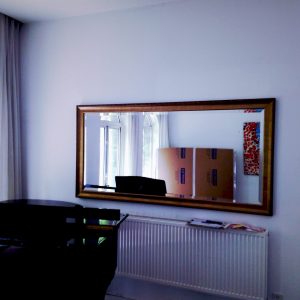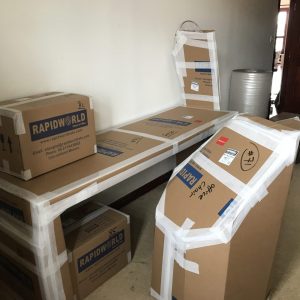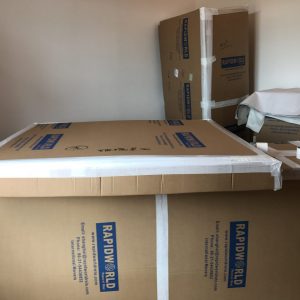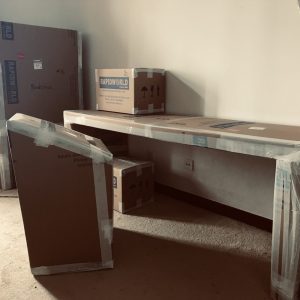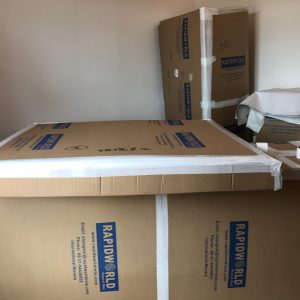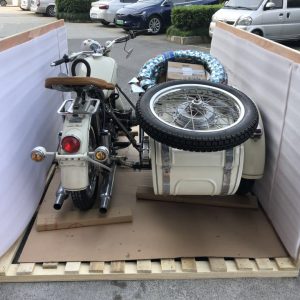Moving from China to Italy? Shipping Furniture & Personal Effects to Italy?RapidWorld Relocations is a leading international moving company in China with offices in Beijing, Guangzhou and Shanghai.
Submit a quote request, email us or call us at 86-21-5443-6852, and we will get back to you shortly.
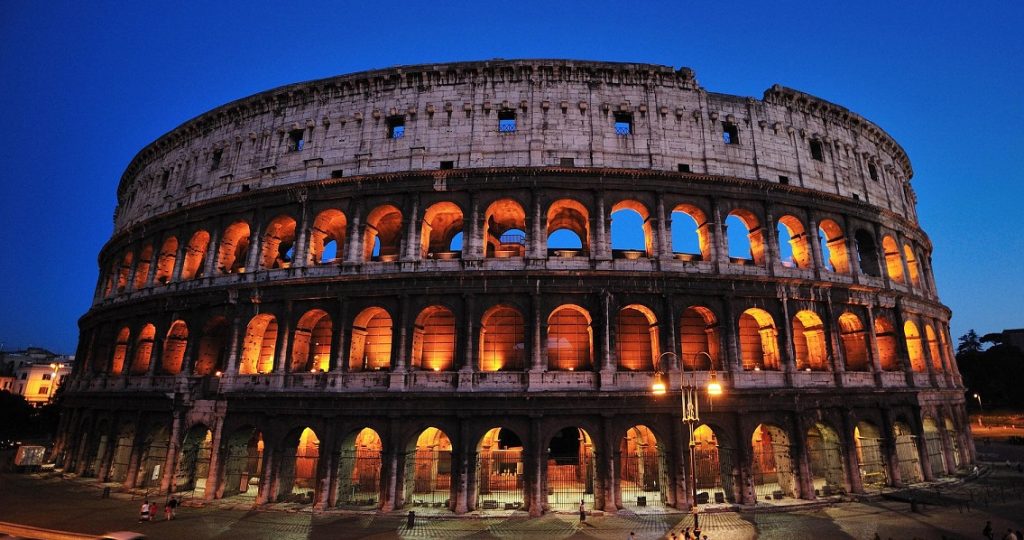
Italy, officially the Italian Republic, is a unitary parliamentary republic in Europe. Located in the heart of the Mediterranean Sea, Italy shares open land borders with France, Switzerland, Austria, Slovenia, San Marino and Vatican City. Italy covers an area of 301,338 km2 (116,347 sq mi) and has a largely temperate seasonal and Mediterranean climate. Due to its shape, it is often referred to in Italy as lo Stivale (the Boot). With 61 million inhabitants, it is the fourth most populous EU member state.
Since classical times, ancient Phoenicians, Carthaginians and Greeks established settlements in the south of Italy, with Etruscans and Celts inhabiting the centre and north of Italy respectively and various different ancient Italian tribes and Italic peoples dispersed throughout the Italian Peninsula and insular Italy. The Italic tribe known as the Latins formed the Roman Kingdom, which eventually became a republic that conquered and assimilated other nearby civilisations. Ultimately the Roman Empire emerged as dominant power in the Mediterranean basin, conquering much of the ancient world and becoming the leading cultural, political and religious centre of Western civilisation. The legacy of the Roman Empire is widespread and can be observed in the global distribution of civilian law, republican governments, Christianity and the Latin script. During the Early Middle Ages, Italy suffered sociopolitical collapse amid calamitous barbarian invasions, but by the 11th century numerous rival city-states and maritime republics rose to great prosperity through shipping, commerce and banking, laying down the groundwork for modern capitalism. These independent statelets, acting as Europe’s main spice trade hubs with Asia and the Near East, often enjoyed a greater degree of democracy and wealth in comparison to the larger feudal monarchies that were consolidating throughout Europe at the time, though much of central Italy remained under the control of the theocratic Papal States, while Southern Italy remained largely feudal until the 19th century, partially as a result of a succession of Byzantine, Arab, Norman, Spanish and Bourbon conquests of the region. The Renaissance began in Italy and spread to the rest of Europe, bringing a renewed interest in humanism, science, exploration and art. Italian culture flourished at this time, producing famous scholars, artists and polymaths such as Leonardo da Vinci, Galileo, Michelangelo and Machiavelli. Italian explorers such as Marco Polo, Christopher Columbus, Amerigo Vespucci and Giovanni da Verrazzano discovered new routes to the Far East and the New World, helping to usher in the European Age of Discovery. Nevertheless, Italy’s commercial and political power significantly waned with the opening of the Atlantic trade route and the route to the Indian Ocean via the Cape of Good Hope, which bypassed the Mediterranean. Furthermore, the Italian city-states constantly engaged one another in bloody warfare, culminating in the Italian Wars of the 15th and 16th centuries that left them exhausted, with no one emerging as a dominant power. The weakened sovereigns soon fell victim to conquest by European powers such as France, Spain and Austria. By the mid-19th century, a rising movement in support of Italian nationalism and independence from foreign control led to a period of revolutionary political upheaval known as the Risorgimento, which sought the formation of a unified nation-state. After various unsuccessful attempts, the Italian Wars of Independence and the Expedition of the Thousand resulted in the eventual unification of the country in 1861, now a great power after centuries of foreign domination and political division. From the late 19th century to the early 20th century, the new Kingdom of Italy rapidly industrialised, although mainly in the north, and acquired a colonial empire, while the south remained largely impoverished and excluded from industrialisation, fuelling a large and influential diaspora. Despite being one of the main victors in World War I, Italy entered a period of economic crisis and social turmoil, leading the way to the rise of a fascist dictatorship in 1922. The subsequent participation in World War II on the Axis side ended in military defeat, economic destruction and an Italian civil war. Following the liberation of Italy and the rise of the resistance, the country abolished the monarchy, reinstated democracy, enjoyed a prolonged economic boom and, despite periods of sociopolitical turmoil (e.g. Anni di piombo, Mani pulite, the Second Mafia War, the Maxi Trial and subsequent assassinations of anti-mafia officials), became a major advanced economy. Today Italy has the third largest GDP in the Eurozone and the eighth largest in the world. As an advanced economy it also has the sixth worldwide national wealth. It has a very high level of human development and is ranked sixth in the world for life expectancy. The country plays a prominent role in regional and global economic, military, cultural and diplomatic affairs, and it is both a regional power and a great power. Italy is a founding and leading member of the European Union and the member of numerous international institutions, including the UN, NATO, the OECD, the OSCE, the WTO, the G7, G20, the Union for the Mediterranean, the Council of Europe, Uniting for Consensus and many more. As a reflection of its cultural wealth, Italy is home to 53 World Heritage Sites, the most in the world, and is the fifth most visited country. For centuries divided by politics and geography until its eventual unification in 1861, Italy has developed a unique culture, shaped by a multitude of regional customs and local centres of power and patronage. During the Middle Ages and the Renaissance, a number of magnificent courts competed for attracting the best architects, artistis and scholars, thus producing an immense legacy of monuments, paintings, music and literature. Italy has more UNESCO World Heritage Sites (53) than any other country in the world, and has rich collections of art, culture and literature from many different periods. The country has had a broad cultural influence worldwide, also because numerous Italians emigrated to other places during the Italian diaspora. Furthermore, the nation has, overall, an estimated 100,000 monuments of any sort (museums, palaces, buildings, statues, churches, art galleries, villas, fountains, historic houses and archaeological remains). Your holidays will be definitely be filled with seeing those sites after relocating to Italy.
When it comes to moving to Italy, there is a process that is long established and RapidWorld is able to help you resolve any issues. From arranging visas, finding properties and school places, to helping you decide what to take, packing it and shipping it to your new home, you won’t be alone. Our services cover whole China span including Beijing, Shanghai, Guangzhou, Shenzhen, Tianjin, Wuhan, Hangzhou, Suzhou, Guilin, Guiyang, Xiamen, Jinan, Nanchang, Changchun, Harbin, etc. We can move you to everywhere in Italy including Milan, Venice, Rome, Florence, etc. Here below are some important information regarding moving personal used household goods and effects to France. Please feel free to contact us should you have any question.
PROHIBITED ITEMS
The items prevented from entering Italy are those that would injure community health, public safety, living things or those that would defeat the national political interests. The following list may be subject to changes anytime:
• Dangerous/hazardous goods (such as, fireworks or toxic/poisonous substances).• Pornographic material or media.• Narcotics, drugs, drug paraphernalia.• Seditious and treasonable materials.• Unprocessed furs and skins.• Furs/skins of cats/dogs.• Protected Animals/Vegetables species underWashington’s Agreement (CITES).• Any item used for torture, or other inhuman/cruel/degrading treatments.• High technology military materials with restrictive measures against Iran.• Any flammable/chemical product.• Ivory and ivory related products.• Any Item that can reduce the ozone layer.• Alcohol, liquids, wine.• Food.• Tobacco, cigarettes.• Living/dried plants, seeds.
Restricted items
Restricted means that special licenses or permits are required from Local/Administrative offices before the item is allowed to enter in Italy. The following list may be subject to changes anytime:
• Firearms, shotguns, rifles, ammunitions (subject to special permission, which must be requested some weeks in advance. These items must arrive prior to the shipment’s arrival, with possible delays of release of the shipment).• Antiques (generally subjects to Fine Arts authorization).• Silica gel (usually discouraged because of delays during the import process. Specialauthorization/documents must be provided before clearance starts).
IMPORT DUTY
Please note: The VAT charged on dutiable shipments, could increase without any advice. If the shipper does not provide the required documents or does not meet the import customs requirements listed above, customs duties and taxes will apply. Taxes/duties being paid directly by the shipper must be done at time of clearance , otherwise, additional delays and costs will incur.
• Personal effects and household goods – 32 % of duties and VAT (on declared value toCustoms or on the Autocertificazione form.• Vehicles – 10% of duties plus 22% VAT (on CIF value).
Example:CIF value of the car: Euro 100,00Duties: Euro 10,00 (Euro 100,00 x 10%)Taxes: Euro 24,10 (Euro 100,00 CIF value of the car plus Euro 10,00 of duties) Euro 110,00 x 22%Total amount due: Euro 10,00 + Euro 24,10 = Euro 34,10
AUTOMOBILES/MOTORBIKES
Italian returning citizens and expatriates• Original logbook .• Original legalized translation of the logbook at the Italian Consulate in the departure Country.• Original export declaration.• Original Autocertificazione Form, in Italian. (Customs require the original form with the original signature of transferee. In addition, please send a copy via email).• Indicate the vehicle on the “Consular Rempatriation Certificate” (applies to Italian returning citizens only). DIPLOMATIC SHIPMENT
To obtain customs exemption, please mark all diplomatic shipments clearly as “DIPLOMATIC” inall documents as well as physically marking the shipment. The destination embassy/UNorganizations must apply Import Permit from customs by themselves.
DOCUMENTS REQUIRED
Expatriates
Foreign citizens must follow these steps to obtain the “residence request/permit” document required for importing free of duty. Once the visa is obtained, the required time for having residence is approximately four to five months.
o Obtain Working Visa from employer.o Obtain Nulla Osta (authorization to work in Italy.)o Request “Codice Fiscale.”o Obtain Permit of Stay (PSE – European Permit of Stay.)o Request “Residence request” *to the new Town Hall of residence in Italy (Town Hall Residency Registration.)• Passport copy (page with picture and signature.)• Codice Fiscale copy (document released by Registry Office at the new Town Hall where the client is taking residence.)• Original Autocertificazione Form, in Italian. (Customs require the original form with the original signature of transferee. In addition, please send a copy via email).• New Residence certificate *.o Document released by the new Town Hall city of residence in Italy.o LCL shipments must send original documents via by express courier.• Usmaf declaration copy (conformation that no silica gel has been added into the shipment.If it present, the import procedure will take longer, incurring delays and demurrages charges.)o Leave all lines blank.o Tick box number one “Nono sono presenti bustine con sostanze antimuffa/antiumidità”(there is no silica gel added).o Sign the document at the end of the page.• Dichiarazione Libera Importazione copy (free import declaration). This confirms that the shipper will not send any of the listed or prohibited items:o Shipper’s given and surname on the first line.o The document must be signed at the end of the page.• Declaration copy from the employer abroad for at least one year. (This document is valid only for containers at Genoa port):o The declaration from the employer (in Italian) abroad, must be on letterhead with company stamp and signature (below examples are in Italian and English), with period of working dates and the job position of the shipper abroad.• Canone Rai’s proof of payment copy for the year of import. (If the television appliance is indicated in the packing list or Consular Rempatriation certificate, import customs need to see proof payment for the Canone Rai (Italian tax for possession of television’s, one payment for each family) has been paid. More information can be found in the following links:o http://www.abbonamenti.rai.it/Ordinari/Ordinari.aspxo http://www.abbonamenti.rai.it/Ordinari/ImportiDiCanone.aspx
Italian returning citizensThe documents required for expatriates also applies to Italian returning citizens. In addition, the following is required for personal effects and household goods:• Returning Italian citizens must have lived outside Italy for at least 12 months.• Shipper must be registered at AIRE for at least 12 months (Association for Italians that had Residence outside Italy).• Shipper must re-apply for their Italian residence before the arrival of the shipment. DIPLOMATS
• Import permit (the embassy/organization must apply for an import permit from Customs once after shipment arrives).• Application Form for Import of Personal Effects (the form must be chopped by the employer and signed by the transferee).• Valid diplomatic and passport copies.
CLEARANCE PROCEDURESItalian customs have recently intensified inspections on incoming shipments.When a shipment is selected from the customs system, one (or more) of the following procedures can apply:
1) Documental inspection2) Scanner inspection3) Physical inspection
When one (or more) of these inspections take place, additional charges will apply with possible delays in the shipment’s release. These costs be passed back to the origin branch:
• Demurrages• Port storage charges• Inspection fee• Documents issued by customs authorities• Unload/reload of HHGS• X-ray exams
Customs clearance times
| Air Shipments | Surface Shipment (FCL) | Surface Shipment (LCL) |
| 3-5 working days | 3-5 working days | 5-10 working days |
Above times are estimates only and on the basis that all required documents are available and in order. Actual time for customs clearance may be subject to change. For more information please contact destination office.
Customs and quarantine procedures
See above
| Above times are estimates only and on the basis that all required documents are available and in order. Actual time for customs clearance may be subject to change. For more information please contact RapidWorld. |

